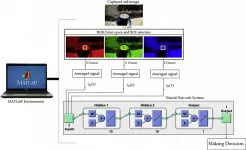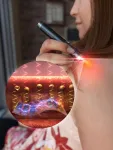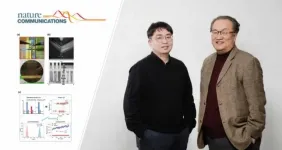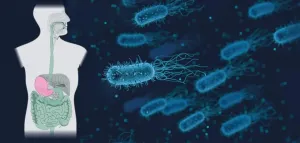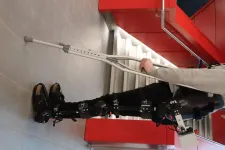INFORMATION:
Notes to editors:
Professor Javaan Chahl and Dr Ali Al-Naji are world leaders in the use of computer vision to monitor heart and respiratory rates.
Professor Chahl's work on a computer vision system able to detect symptoms of COVID-19 made international headlines last year.
World Water Day is Monday 22 March, highlighting the importance of fresh water around the planet.
Media:
Dan Lander | mobile: 0408 882 809 | email: dan.lander@unisa.edu.au
Standard digital camera and AI to monitor soil moisture for affordable smart irrigation
2021-03-15
(Press-News.org) Researchers at UniSA have developed a cost-effective new technique to monitor soil moisture using a standard digital camera and machine learning technology.
The United Nations predicts that by 2050 many areas of the planet may not have enough fresh water to meet the demands of agriculture if we continue our current patterns of use.
One solution to this global dilemma is the development of more efficient irrigation, central to which is precision monitoring of soil moisture, allowing sensors to guide 'smart' irrigation systems to ensure water is applied at the optimum time and rate.
Current methods for sensing soil moisture are problematic - buried sensors are susceptible to salts in the substrate and require specialised hardware for connections, while thermal imaging cameras are expensive and can be compromised by climatic conditions such as sunlight intensity, fog, and clouds.
Researchers from The University of South Australia and Baghdad's Middle Technical University have developed a cost-effective alternative that may make precision soil monitoring simple and affordable in almost any circumstance.
A team including UniSA engineers Dr Ali Al-Naji and Professor Javaan Chahl has successfully tested a system that uses a standard RGB digital camera to accurately monitor soil moisture under a wide range of conditions.
"The system we trialled is simple, robust and affordable, making it promising technology to support precision agriculture," Dr Al-Naji says.
"It is based on a standard video camera which analyses the differences in soil colour to determine moisture content. We tested it at different distances, times and illumination levels, and the system was very accurate."
The camera was connected to an artificial neural network (ANN) a form of machine learning software that the researchers trained to recognise different soil moisture levels under different sky conditions.
Using this ANN, the monitoring system could potentially be trained to recognise the specific soil conditions of any location, allowing it to be customised for each user and updated for changing climatic circumstances, ensuing maximum accuracy.
"Once the network has been trained it should be possible to achieve controlled irrigation by maintaining the appearance of the soil at the desired state," Prof Chahl says.
"Now that we know the monitoring method is accurate, we are planning to design a cost-effective smart-irrigation system based on our algorithm using a microcontroller, USB camera and water pump that can work with different types of soils.
"This system holds promise as a tool for improved irrigation technologies in agriculture in terms of cost, availability and accuracy under changing climatic conditions."
ELSE PRESS RELEASES FROM THIS DATE:
Weed invaders are getting faster
2021-03-15
Dr Daniel Montesinos is a Senior Research Fellow at the Australian Tropical Herbarium, at James Cook University in Cairns. He is studying weeds to better understand (among other things) how they might respond to climate change.
He said most invasive plants are characterised by their rapid pace when it comes to taking up nutrients, growing, and reproducing - and they're even faster in the regions they invade.
"New experiments comparing populations from distant regions show a clear trend for already-fast invasive plants to rapidly adapt even faster traits in their non-native regions," Dr Montesinos said.
This is further pronounced in the tropics and sub-tropics.
"Even though invasives' growth rates are already among the highest for plants, when they invade new territory ...
Injections or light irradiation?
2021-03-15
A new concept of on-demand drug delivery system has emerged in which the drugs are automatically released from in vivo medical devices simply by shining light on the skin.
A research team led by Professor Sei Kwang Hahn of the Department of Materials Science and Engineering and Professor Kilwon Cho of the Department of Chemical Engineering at POSTECH have together developed an on-demand drug delivery system (DDS) using an organic photovoltaic cell coated with upconversion nanoparticles. This newly developed DDS allows nanoparticles to convert skin-penetrating near-infrared (NIR) light into visible light so that drug release can be controlled in medical ...
Researchers present spontaneous sparse learning for PCM-based memristor neural networks
2021-03-15
An international team of researchers, affiliated with UNIST has unveiled a novel technology that could improve the learning ability of artificial neural networks (ANNs).
Professor Hongsik Jeong and his research team in the Department of Materials Science and Engineering at UNIST, in collaboration with researchers from Tsinghua University in China, proposed a new learning method to improve the learning ability of ANN chips by challenging its instability.
Artificial neural network chips are capable of mimicking the structural, functional and biological features of human neural networks, and thus have been considered the technology of the future. In this study, the research team demonstrated the effectiveness of the proposed learning method ...
Enzymatic danse macabre of lung cancer
2021-03-15
A chromatin-regulating enzyme has been shown by in-depth interdisciplinary investigations to be a key driver of a common type of lung cancer. Drugs that target the enzyme could improve treatment and survival rates for this particular cancer.
"Squamous cell carcinoma represents nearly one third of all lung cancers in humans," says KAUST structural biologist Lukasz Jaremko, who led the research along with colleagues at Stanford University and The University of Texas MD Anderson Cancer Center, U.S. "Our joint structural and dynamics investigations, including enzymatic activity studies, genetic analyses, and mouse model and human cell results, ...
Bacteria adapt syringe apparatus to changing conditions
2021-03-15
Basic, acidic, basic again: for pathogenic bacteria such as Salmonella, the human digestive tract is a sea change. So how do the bacteria manage to react to these changes? A team of researchers from the Max Planck Institute for Terrestrial Microbiology in Marburg led by Andreas Diepold has now provided a possible explanation: pathogenic bacteria can change components of their injection apparatus on the fly - like changing the tires on a moving car - to enable a rapid response.
Some of the best-known human pathogens - from the plague bacterium Yersinia pestis to the diarrhea pathogen Salmonella - use a tiny hypodermic needle to inject disease-causing ...
How artificial intelligence can help curb traffic accidents in cities
2021-03-15
Despite pandemic-driven restrictions on movement, there were over 12,000 accidents in Madrid in 2020, leading to 31 fatalities. In Barcelona, there were more than 5,700 collisions, causing 14 deaths. Pedestrian and vehicle safety is a priority, which is why a research project at the Universitat Oberta de Catalunya (UOC) is harnessing artificial intelligence (AI) to make decisions that will make cities safer. The researchers have looked into the correlation between the complexity of certain urban areas and the likelihood of an accident occurring there.
According to the researchers, the data they have gathered can be used to train neural networks to detect probable ...
A law to protect those who support victims of violence against women
2021-03-15
Last December, the Parliament of Catalonia unanimously approved the incorporation into its legislation of second-order violence against those who give their support to victims of violence against women. A recent study compiles testimonies of victims, and analyses this form of intimidation
To tackle violence against women, it is essential for victims to have the support of those surrounding them and to prevent them from being isolated. But what happens if the people around them are not protected? The work of Jose Ramón Flecha García, founder of the Community of Research on Excellence for All (CREA), and various academic teams, has led to the approval in the Catalan parliament of the first legislation on the Second Order of Sexual Harassment (SOSH).
The following point ...
Engineers combine AI and wearable cameras in self-walking robotic legs
2021-03-15
Robotics researchers are developing exoskeletons and prosthetic legs capable of thinking and moving on their own using sophisticated artificial intelligence (AI) technology.
The system combines computer vision and deep-learning AI to mimic how able-bodied people walk by seeing their surroundings and adjusting their movements.
"We're giving robotic legs vision so they can control themselves," said Brokoslaw Laschowski, a PhD candidate in systems design engineering who leads a University of Waterloo research project called ExoNet.
Exoskeletons and prosthetic devices operated by motors already exist, but users must manually ...
New probe set unravels evolutionary history of second-most diverse group of land plants
2021-03-15
In 2016, a collaborative group of research and education specialists received funding from the National Science Foundation for the project 'Building a Comprehensive Evolutionary History of Flagellate Plants' -- also known as 'Genealogy of Flagellate Plants' (GoFlag). Members of the team have the ambitious goal of reconstructing the 470-million-year history of one of the most diverse groups of land plants on the planet.
The first of several forthcoming publications from the project was published in a recent issue of Applications in Plant Sciences. In their inaugural article, the researchers report on the successful development of 451 nuclear target enrichment probes, which correspond to short, variable loci.
By creating a standard ...
Model predicts urban development and greenhouses gasses will fuel urban floods
2021-03-15
When rain began falling in northern Georgia on Sept. 15, 2009, little did Atlantans know that they would bear witness to epic flooding throughout the city. Neighborhoods, like Peachtree Hills, were submerged; Georgia's busiest expressway was underwater, as were roads and bridges; untreated sewage mingled with rising flood waters; cars and people were swept away. Then-Georgia-governor, Sonny Perdue, declared a state of emergency.
Moisture from the Gulf of Mexico fueled the flood of 2009. A decade later, Arizona State University researchers are asking whether a ...
